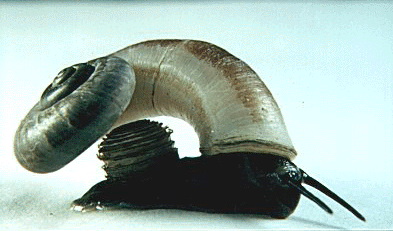|

Gastropod Main

Glossary

References

Links

Hooper Main |
Evolution 2
 |
Figure 3: A Modern Prosobranch. This is a Rhiostoma chupingense, of the Family Cyclophoridae found in western Malaysia. Note the prominent operculum. |
Both the pulmonates and prosobranchs have adapted to land. The more primitive prosobranchs, most of which are still marine, survived the harsher and drier terrestrial conditions by changing patterns of behaviour. Most had an operculum which allowed them to seal themselves inside their shells to prevent water loss in dry climates. This also allowed them to hide from predators on land, just like they do in a marine environment.

|

|

|

|

|

